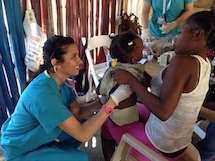Priya Soni, MD: MMC Pediatrics PGY3
Haiti: November 2014

It was a hot Thursday morning. One of the nurses had graciously offered her personal home for us to set up a make shift clinic inside of it. We rearranged some furniture, sifted and divided the medications and set up our stations. This was an all too familiar routine by now. It was 9am but over a hundred people gathered outside. There were children, of all ages, some with their mothers, some without. Some brought in by their grandparents. All were lined up eagerly and orderly. This area called Madlin was home to the sickest children I had seen on our entire trip. The first patient I saw was a 7 year old with a labial abscess. Too poor to buy underwear, the dress she wore revealed the infected area quickly and I had to reflexively clean her wound, treat her infection and somehow make her a pair of underwear to prevent the pus from touching open surfaces. One of the nurses and I suddenly had the brilliant idea of cutting a portion of a sterile surgical gown and creating an undergarment out of this fabric that we dispose of so carelessly in the USA. We had become mini-Macgyver’s – finding use in even the most minuscule objects. Everything had use in Haiti.
The day continued and the patients kept coming. As the week had progressed I had become accustomed to the sound of the Creole words for the salient medical questions that Ilea my interpreter would ask on my behalf. There was a flow to our clinic now. Towards the end of the day, two sisters about 5 and 8 years old sat down on my bench. The first complaint was that the younger one had fevers and night sweats for the last “5 years” as per the grandfather. The older sister echoed her sister’s symptoms completely. The suspicion for malaria grew in my head. I had the girls go to our laboratory or rather the side of the house where one of the Haitian nurses took a sample of the girls’ blood and ran a rapid malaria screen on. In addition to this, there was a small battery operated microscope with a blood slide prepared for my viewing. Not only was I able to diagnose malaria for the first time in the field but I was able to treat and help alleviate the pain and suffering for these two children and improve the quality of their lives. In that moment, I was excited and proud of the way true western medicine was accessible and accurate in even the most remote areas of the world where infrastructure and order hardly exists.
The best part about working in Haiti was the fact that I knew I was part of something sustainable and real. Each encounter provided an eye opening opportunity to positively affect children in a small way. I have to believe that all of our actions meant something greater and that with the constant presence of Hands up for Haiti in these communities there is a lasting impression and impact on some people that truly do need the help the most. I loved that feeling and hope to return again soon.